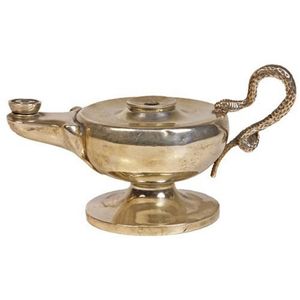Dutch Silver Coffee-Pot on Stand with Brazier, 1844
You must be a subscriber, and be logged in to view price and dealer details.
Subscribe Now to view actual auction price for this item
When you subscribe, you have the option of setting the currency in which to display prices to $Au, $US, $NZ or Stg.
- Embossed / Repousse - Embossing, also known as repousse, is the technique of decorating metal with raised designs, by pressing or beating out the design from the reverse side of the object.It is the opposite of chasing, where the decoration is applied from the front. An embossed or repoussed object may have chasing applied to finish off the design.
- Canted Corners - In decorative arts, especially furniture making, a canted corner refers to a technique where the corner of the piece is angled or "canted" to create a diagonal corner. This is different from a chamfered corner which is a technique where the edges of a corner are cut at an angle, creating a diagonal edge or "bevel" along the corner.
A canted corner is typically used to add visual interest to the item. It can be found in various styles of furniture such as contemporary, Art Deco, or traditional. It is often used to create a sense of movement and dynamism in a piece.
Canting a corner is a more complex technique than chamfering, and it is typically done by tilting the corner of a piece of furniture and then cutting the wood to match the angle. It's a technique that requires precise measurements and a good understanding of angles and geometry, and it is usually done by experienced artisans. - Ebony - Ebony is a close grained timber, black in colour. It has a fine texture which can be polished to a high gloss, making it suitable for venereering, inlay and stringing and its use as solid timber is resticted to small decorative items and ornamental decoration, such as chess pieces and musical instrument parts. The term "ebonised" means "faux ebony", timber that has been darkened during the polishing process to resemble ebony.
- Quatrefoil - A stylised four-circle design, itself contained within a larger circle, with Gothic origins and often seen as window designs in ecclesiastical architecture. The use of the motif was popular in Gothic Revival furniture of the 19th century.
This item has been included into following indexes:
Visually similar items

A German silver four piece coffee and tea set, of fluted baluster form, stylised flower bud finials. Weight 2.25kgs, stamped 800 to base.

George V silver coffee pot, mark of C. S. Harris & Sons Ltd., London, 1911, of tall baluster shape, with domed hinged lid and ebony double scrolled handle, hallmarked, approx. Weight 535 grams

English hallmarked sterling silver Victorian oil lamp with a snake handle. Sheffield, 1898, maker Mappin & Webb. Length 13.5 cm. Weight 184g

A George IV sterling silver two handled cup with ornate raised floral scroll decoration on circular footed base and gilt interior. Birmingham, 1829. Weight 480g. Height 17.5 cm
